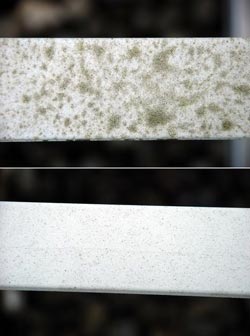Cleaning with sunlight

The surface coated with titanium<br>dioxide molecules (bottom) looks very<br>different from the non-coated sample<br>(top). (© Fraunhofer IGB)<br>
Summer is just around the corner and it’s time to dust off the garden tables and chairs. But garden furniture that has been left in the shade too long is often covered with a slimy film of algae, moss, bacteria and fungi which is difficult or even impossible to remove.
Scientists are now hoping that they can solve this problem by incorporating titanium dioxide molecules in the plastic used to make the garden chair and adding a little bit of sunlight. When these titanium dioxide molecules are ‘activated’ by the UV light in the sun’s rays, they act as a kind of catalyst, triggering an electrochemical reaction which produces free radicals. These and other active molecules strike a fatal blow to bacteria, fungi and similar organisms, first destroying the cell walls and then penetrating the cytoplasm – the substance that fills the cell – and damaging the bacteria’s DNA. As a result, the organic substances are destroyed instead of remaining stuck to the surface.
But just how well do these photocatalytic coatings work? What organic elements do they destroy, and what are they powerless against? These two questions have been the subject of investigation by researchers at the Fraunhofer Institute for Interfacial Engineering and Biotechnology IGB in Stuttgart. “For example, we ran some outdoor tests on garden chair armrests with photocatalytic coatings and compared them to ones made from conventional plastic,” says Dr. Iris Trick, group manager at the IGB. Dr. Trick and her team sprayed the coated and uncoated armrests with a mixture of various bacteria, mosses, algae and fungi and then left them exposed to the weather for two years.
At the end of the test, it was almost impossible to remove the layer of dirt from the normal armrests – yet the armrests made from photocatalytic plastics were still almost completely clean and white, even after spending two years outside. The researchers also tested the effectiveness of their special coatings on armrests and a range of other surfaces in the lab. To do this, they applied up to 30 different kinds of fungal, bacterial and algal cultures to coated and uncoated surfaces and compared how the cultures evolved. In addition, they analyzed the degradation products generated on the self-cleaning surfaces by the electrochemical reaction.
Self-cleaning walls and displays
The opportunities offered by titanium dioxide molecules extend far beyond armrests. For example, researchers from the Fraunhofer Institute for Manufacturing Engineering and Automation IPA in Stuttgart are working on paints for building façades which contain titanium dioxide particles. If the wall gets dirty, the photocatalysis degrades the organic contaminants and the paint stays reasonably clean. The scientists have even developed a self-cleaning coating for glass surfaces: “If you apply a thin coating of titanium dioxide to a glass surface such as a smartphone screen, the skin oils and fingerprints gradually disappear from the display by themselves,” says Dr. Michael Vergöhl, head of department at the Fraunhofer Institute for Surface Engineering and Thin Films IST in Braunschweig and head of the Fraunhofer Photocatalysis Alliance. All that is needed is one hour of sunlight – unlike previous photocatalytic surfaces, which would have required the smartphone to be left in the sun for three days.
The next step is to develop new materials that can also be activated by artificial light. The Fraunhofer Photocatalysis Alliance is a group of ten Fraunhofer institutes which have decided to combine their expertise in this field. It covers the full spectrum of photocatalytic surface development and offers considerable know-how from a single source.
Media Contact
All latest news from the category: Materials Sciences
Materials management deals with the research, development, manufacturing and processing of raw and industrial materials. Key aspects here are biological and medical issues, which play an increasingly important role in this field.
innovations-report offers in-depth articles related to the development and application of materials and the structure and properties of new materials.
Newest articles

Machine learning algorithm reveals long-theorized glass phase in crystal
Scientists have found evidence of an elusive, glassy phase of matter that emerges when a crystal’s perfect internal pattern is disrupted. X-ray technology and machine learning converge to shed light…

Mapping plant functional diversity from space
HKU ecologists revolutionize ecosystem monitoring with novel field-satellite integration. An international team of researchers, led by Professor Jin WU from the School of Biological Sciences at The University of Hong…

Inverters with constant full load capability
…enable an increase in the performance of electric drives. Overheating components significantly limit the performance of drivetrains in electric vehicles. Inverters in particular are subject to a high thermal load,…





















